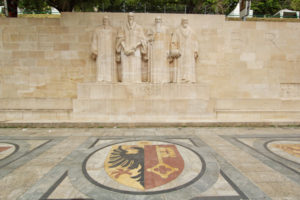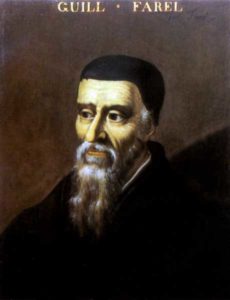Young Theologian’s Impact on the Reformation
Where does John Calvin Fit into the Reformation?
While on a Reformation Tour you will be immersed in historical context of the Reformation. You will explore the lives and teachings of the Reformers, and resulting effects of their preaching of Reformed Theology. John Calvin, a major figure in the movement, is one of the subjects of Dr. Erwin Lutzer’s teaching.
Martin Luther and John Calvin
Nineteen years after Martin Luther nailed the 95 Theses to the door of a Catholic church in Germany, John Calvin, a French theologian and pastor, was asked to become a leader of the Protestant movement in Geneva, Switzerland. He joined the Lutherans in teaching the Three Solas of Protestantism:
- Sola Fide – Faith alone. We are never justified by works
- Sola Gratia – Grace alone. We can never do anything to merit God’s acceptance
- Sola Scriptura – Scripture alone. No beliefs are necessary to accept unless they are in the Bible
Predestination was a new doctrine from Calvin. It meant that believers can and should know they are among the elect, predestined for salvation. They can be certain, even in this life, that they are already saved for eternity. In his book, Rescuing the Gospel, Dr. Erwin Lutzer writes,
“Calvin believed that the fall of humanity into sin was so pervasive and affected people’s minds and wills so much that they couldn’t believe the truths of the gospel unless God were to perform a miracle of regeneration in their hearts. Because God’s purposes can never be thwarted, it was exactly such a miracle that God performed in the hearts of His elect.” Lutzer, p 164
John Calvin’s Rise and Impact
Calvin’s own testimony was likely influenced by the spread of the Gospel spurred on by Martin Luther and his initial stand against the Catholic Church. “He (Calvin) says that God turned his course in a different direction by the hidden bridle of His providence. ‘My mind…, despite my youth, had been hardened… By a sudden conversion God turned and brought it to docility.’ God, he said, tamed his mind and overcame his darkness, resulting in his conversion.” (Lutzer, p 164).
Calvin’s theology was a major force in the development of the Protestant doctrine of justification. He became known for a textbook he wrote at the age of 27, called Institutes of the Christian Religion. It was written as an introductory textbook on the Protestant faith. This book on Reformed theology is still read today.
When deadly violence brout out against the protestants in France, he fled to Switzerland. Lutzer shares, “Calvin had gone to Geneva to escape the persecution of Protestants in France, and when he arrived, he was surprised that the people there had heard of him.” (Lutzer 162). Because of his youth and inexperience, he was hesitant to lead the Protestant movement. Yet, after some persuasion from prominent leader Guillaume Farel, he became a “second generation” reformer. Both men’s images are carved into the Reformation wall in Geneva.
References: Luzter, E. (2016). Rescuing the Gospel. Ada, MI: Bakers Publishing Group.



